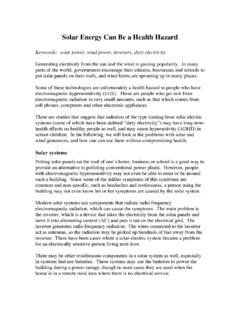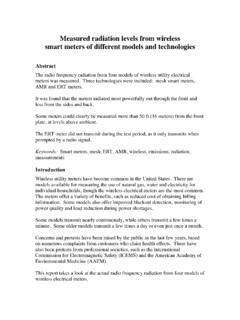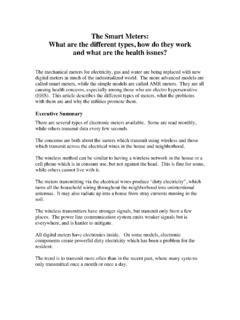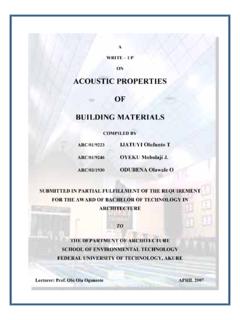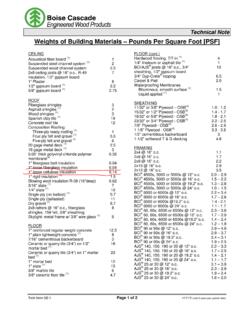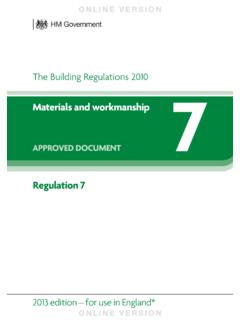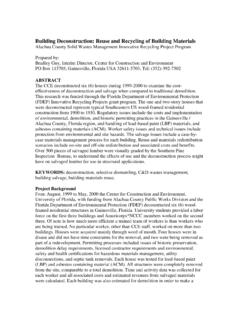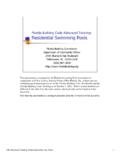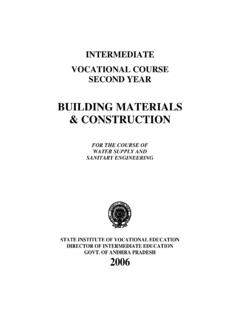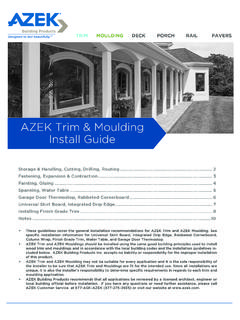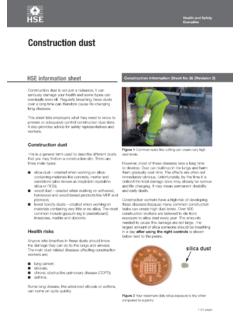Transcription of Shielding by building materials - EI Wellspring
1 EMF Shielding by building materials Attenuation of microwave band electromagnetic fields by common building materials The National Institute of Standards and Technology (NIST) and the University of the German Federal Armed Forces have separately done extensive testing of how well various common building materials can shield (dampen) electromagnetic fields. A wide range of materials and thicknesses were tested, such as bricks, concrete, lumber, drywall, plywood, glass and rebar. Keywords: microwave, radio frequency, RF, Shielding , building , materials , concrete, bricks, window, Shielding fabric, Shielding paint The need for Shielding The ambient levels of microwave radiation have risen exponentially since the mid-1990s and have reached levels where independent scientists are concerned about the public health.
2 There are also people who are hypersensitive to this type of radiation and have acute symptoms at levels common in cities. building houses of Shielding materials , or Shielding existing houses, may be a solution to this public health issue. The problem is to get sufficient Shielding , since a reduction (attenuation) of the radiation will often need to be 20 dB (hundredfold) or more. Microwave frequencies The tests were conducted for frequencies that cover emissions from cell phone towers, 3G, 4G, LTE, Wi-Fi, DECT, cordless phones, digital television, GPS, wireless smart meters, baby monitors and many other devices. The frequency bands used by broadcast radio (AM, FM, shortwave, etc.) and wireless power systems were not covered. Since they are lower frequencies, it is reasonable to expect less Shielding of these types of signals than demonstrated in the tests.
3 The new 5G systems will use higher frequencies than used in these tests. The tested materials will probably shield the 5G signals better than 3G/4G signals, though the higher frequencies are better at penetrating small gaps (holes, slits) in the walls of a house, as well as the holes in Shielding fabrics and meshes. 2 Shielding by building materials Measuring Shielding effectiveness The effectiveness of a Shielding material is how much the radiation is reduced while passing through the material compared to when there is unrestricted passage. This is called attenuation. The result is given in decibels. factor reduction decibel 10 90% 10 100 99% 20 1000 30 10,000 40 100,000 50 For Shielding of humans against EMF, these are the magnitudes that are relevant. The tests in these reports were all done by measuring the power density (W/m).
4 When comparing with other sources, be aware that if the measurements are using the field strength (V/m) a reduction of 90% (factor 10) is 20 decibels and a 99% reduction (factor 100) is 40 decibels. The NIST measurements The National Institute of Standards and Technology in the United States published their results in a 1997 report titled Electromagnetic Signal Attenuation in Construction materials (report NISTIR 6055). This report is freely available on the web. The reason NIST did these extensive tests was to prepare for future generations of wireless control systems at construction sites, as well as for tools to measure the thickness of walls. It was not related to protecting the public health against EMF. In general, these tests show that standard building materials provide poor Shielding . materials such as gypsum drywall, glass and lumber are almost fully transparent to microwave radiation.
5 Even bricks are not a very effective Shielding material . The Shielding values do vary with the frequency, with the materials mostly performing better at higher frequencies. However, that is not always the case. Shielding by building materials 3 Concrete NIST tested eight different concrete mixes, each at three different thicknesses. The concrete was solid and without any reinforcement. The key findings were: the attenuation increases with higher frequencies the attenuation varied little between the eight mixes the attenuation depends directly on the thickness of the concrete If a concrete wall that shields (attenuates) by 15 dB is doubled in thickness, the wall will then attenuate by 2 x 15 dB = 30 dB. The measurements also found that thick concrete could provide good Shielding , with typically 25 dB attenuation for eight inches (203 mm) at 1 GHz.
6 However, these measurements turned out to be misleading. The samples NIST used were cured for 28 days, but later measurements by Pauli & Moldan in Germany showed that concrete loses some of its ability to absorb microwaves over time. In their experiments they found that 16 cm (6 inch) concrete attenuates 5 dB less between curing for one month and nine months. Reinforced concrete Concrete reinforced with a mesh of steel rebar is not really better than plain concrete. NIST tested two standard mesh sizes (70 mm and 140 mm between rebars) and compared with a concrete wall without rebar. 19 mm (3/4 ) thick rebar was used on a 203 mm (8 ) thick concrete wall. Concrete 203 mm (8 ) 500 MHz 1 GHz 2 GHz 5 GHz 8 GHz without rebar 23 27 35 55 73 with rebar 140mm OC 23 27 31 53 68 with rebar 70 mm OC 26 30 37 56 71 The above table shows the attenuation in decibel (dB) for concrete that has cured for 28 days.
7 The attenuation will be less when fully cured. 4 Shielding by building materials Concrete blocks Concrete blocks with hollow cavities inside were tested for walls one, two and three blocks thick. The study did not test the Shielding value of the blocks if filled with concrete. It would probably be slightly less than a solid concrete wall of the same thickness. Masonry block (concrete block) 500 MHz 1 GHz 2 GHz 5 GHz 8 GHz 203 mm (8 ) 8 12 11 15 18 406 mm (16 ) 13 17 18 27 30 609 mm (24 ) 26 28 30 39 39 Lumber Regular lumber in thickness up to six inches was tested. The wood was either spruce, pine or fir, which are the typical sorts used for construction in North America. Heavier types of wood, such as oak, may have a better Shielding effect. It was found that fresh (moist) lumber provides more Shielding than lumber that has aged.
8 This must be because of the water content. The table below is for dry lumber. Dry lumber 500 MHz 1 GHz 2 GHz 5 GHz 8 GHz 38 mm ( ) 2 3 4 4 76 mm (3 ) 3 8 9 152 mm (6 ) 6 20 25 Bricks Brick walls consisting of one, two or three bricks were tested. Even three courses of bricks do not provide much useful Shielding , except at the highest frequencies. Brick 500 MHz 1 GHz 2 GHz 5 GHz 8 GHz 89 mm (1 brick) 0 15 16 178 mm (2 bricks) 32 14 267 mm (3 bricks) 4 7 32 27 Shielding by building materials 5 Glass panels Glass window panels with regular clear glass were tested and found to have very little Shielding effect. NIST did not test windows with a metallic coating (low-E), which do provide very significant Shielding (see later). Glass panels 500 MHz 1 GHz 2 GHz 5 GHz 8 GHz 6 mm (1/4 ) 0 1 13 mm (1/2 ) 0 Drywall Gypsum drywall consists of 85-95% gypsum.
9 The rest is mainly paper and various additives. Drywall has no Shielding effect. Drywall 500 MHz 1 GHz 2 GHz 5 GHz 8 GHz 6 mm (1/4 ) 0 13 mm (1/2 ) 0 The German measurements Much more extensive tests of building materials and special Shielding materials were done at the University of the German Federal Armed Forces by Peter Pauli and Dietrich Moldan. Their first report was published in 2000 in both English and German. The English title is Reduction and Shielding of RF and Microwaves: Construction materials , Screens, Wainscots and Tissues. This report can be purchased from Dr. Dietrich Moldan, Am Henkelsee 13, D-97346, Iphofen, Germany. The same authors have since continued their tests and published expanded versions of the original report. The most recent is from 2015. However, these later versions are available in German only.
10 The data is displayed in large colorful charts that can be interpreted with the help of a German dictionary. The 2015 edition is titled Reduzierung hochfrequenter Strahlung im Bauwesen: Baustoffe und Abschirmmaterialien, and is also available from Dr. Moldan. The English version displays data for about 80 different materials while the 2015 German edition lists 150 materials . The materials were tested at frequencies ranging from 100 MHz to 10 GHz using standard test methods (including NATO 6 Shielding by building materials MILSTD 285 and IEEE 299). The results are largely consistent with the NIST results; however, since these reports are copyrighted we can t display the results. As mentioned earlier, a major discovery is that concrete provides less Shielding once it has cured for nine months, compared to after just one month.
